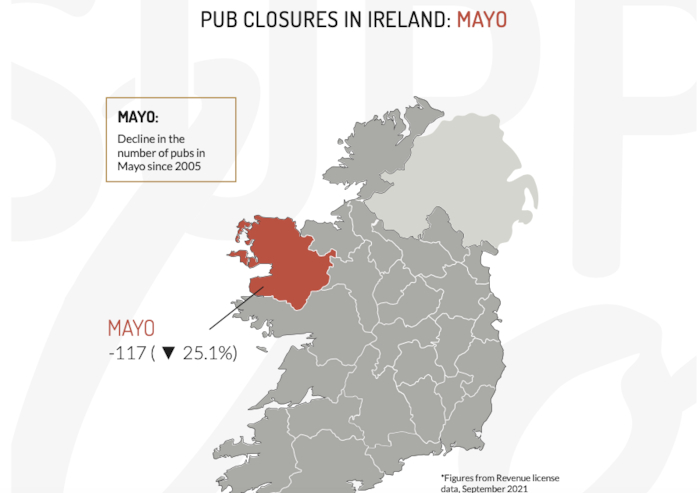A new report from the Drinks Industry Group of Ireland (DIGI ) has shown a stark decline in the number of pubs doing business throughout the country since 2005.
The Irish Pub: Stopping the Decline report, based on the group’s analysis of Revenue license data and including an economic and social analysis by Dublin City University (DCU ) economist Anthony Foley, shows a 21.2% decline in the number of pubs in Ireland from 2005 to 2021.
In Mayo there were 117 less pubs in 2021 than there were in 2005, according to the report, which states that in 2005 there were 467 pubs in Mayo and in 2021 that number had declined to 350. The report also showed the effect of the Covid-19 pandemic on pubs, with 372 pubs in Mayo in 2019, in 2020 there were 355 and in 2021 that number had dropped to 350 a 5.9 per cent decline over that two year three year period.
All 26 counties experienced declines in pub numbers through the 16-year period. The largest decrease was seen in Laois with 30.6% less pubs since 2005. This was the only county with a decrease of 30% or more. The lowest decrease was in Meath with 1.4% less. Meath was followed by Dublin, reporting a decrease of only 4.3%. All the remaining 23 counties had decreases greater than 10%.
Three counties, Carlow (10.4% ), Kildare (13.6% ), and Wicklow (10.1% ) showed decreases between 10% and 14.9% and, five counties, Cavan (17.2% ), Kerry (15.3 ), Kilkenny (18.1% ), Monaghan (19.8% ), and Wexford (17.2% ) were in the 15% to 19.9% decrease bracket.
All the remaining counties had decreases of more than 20%. Six counties, Clare (24.7% ), Galway (20.6% ), Louth (20.3% ), Sligo (24% ), Waterford (23.5% ), and Westmeath (24.4% ) were in the 20% to 24.9% decrease band, while nine counties Cork (28.5% ), Donegal (26.3% ), Leitrim (26.4% ), Limerick 29.1% ), Longford (25.7% ), Mayo (25.1% ), Offaly (29.9% ), Roscommon (28.3% ), and Tipperary (26.3% ) saw decreases between 25% and 29.9%.
The report highlights that many public houses operate at relatively low levels of sales volume. One of the factors which influence business sustainability at these low sales volumes, which is within the control of the Government, is the high Irish alcohol excise level which represents a significant cost on the business.
Paul Clancy, DIGI member and CEO of the Vintners Federation of Ireland, described the report as 'alarming' saying: "1,829 rural pub closures represent businesses that provide jobs, a hub in the local community for socialising and community integration and a cultural centre which has long been documented as among the main attractions for tourists visiting Ireland. The pace of decline increased as a result of the Covid-19 pandemic which saw the drinks and hospitality industry suffer the worst of all, with one of the longest lockdowns recorded globally.
"Considering this sharp decline and trend we’re witnessing, we need to monitor this industry carefully and ensure all the necessary supports are in place to contribute to stopping this trend.
"Our high alcohol excise tax is a cost and slows the growth of these businesses and impacts their day-to-day operations and bottom line. Exasperated currently with inflation and the cost of living. We are calling on the Government to reduce excise tax to support the industry with meaningful measures that will be felt immediately and reduce costs over night for tens of thousands of business owners."

